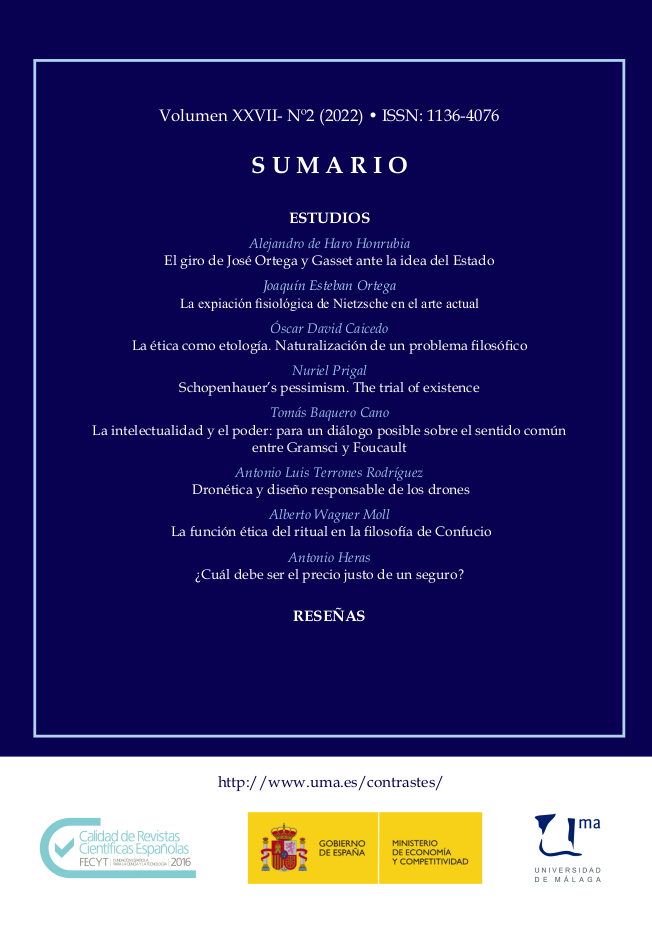What should be the fair premium of an insurance policy?
DOI:
https://doi.org/10.24310/Contrastescontrastes.v27i2.13045Keywords:
Actuarial fairness, mathematical expectation, shared uncertainty, contractualismAbstract
Traditionally, the premiums of the insurance contracts have been considered fair when they mirror exactly the risk of the policies, measured as the mathematical expectation of their claims. In this paper we criticize this seemingly objective approach and we propose an alternative justification for the actuarial fairness, based on contractualist arguments. We build on some intuitions of the 17th French jurist Jean Domat about the shared uncertainty among the stakeholders, in the general framework of the contractualist theory of the contemporary philosopher and economist Robert Sugden.
Downloads
Metrics
Publication Facts
Reviewer profiles N/A
Author statements
Indexed in
-
—
- Academic society
- N/A
- Publisher
- Universidad de Málaga
References
Ashford, E., & Mulgan, T. (2018). Contractualism The Stanford Encyclopedia of Philosophy (Summer 2018 Edition). Retrieved from https://plato.stanford.edu/archives/sum2018/entries/contractualism/
Baker, T. (1993). Constructing the insurance relationship: Sales stories, claims stories, and insurance contract damages. Tex. L. Rev., 72, 1395.
Ceccarelli, G. (2001). Risky business: Theological and canonical thought on insurance from the thirteenth to the seventeenth century. Journal of Medieval and Early Modern Studies, 31(3), 607-658.
Chan, C. S.-c. (2009). Creating a market in the presence of cultural resistance: The case of life insurance in China. Theory and Society, 38(3), 271-305.
Daston, L. (1988). Classical probability in the Enlightenment. Princeton, N.J.: Princeton University Press.
Domat, J. (1689). Les Loix civiles dans leur ordre naturel Paris: J. B. Coignard.
Domat, J., & Cushing, L. S. t. (1689/1850). The civil law in its natural order. Boston: Charles C. Little and James Brown.
Ewald, F. (1991). Insurance and risk. In G. Burchell, C. Gordon, & P. Miller (Eds.), The Foucault effect: Studies in governmentality (pp. 197-210). Chicago: University of Chicago Press.
Ewald, F. o. (1986). L'Etat providence. Paris: B. Grasset.
Hájek, A. (2007). The reference class problem is your problem too. Synthese, 156(3), 563-585.
Hald, A. (1990). A history of probability and statistics and their applications before 1750. New York: Wiley.
Halley, E. (1693). An Estimate of the Degrees of the Mortality of Mankind. Phil. Trans. , January 1(17), 596-610.
Heras, A.J., Pradier, P.Ch., & Teira, D. (2020). What was fair in actuarial fairness? History of the Human Sciences, 33(2), 91-114.
Kosinski, M., Stillwell, D., & Graepel, T. (2013). Private traits and attributes are predictable from digital records of human behavior. Proceedings of the national academy of sciences, 110(15), 5802-5805.
Kvalnes, Ø. (2011). Blurred promises: Ethical consequences of fine print policies in insurance. Journal of Business Ethics, 103(1), 77-86.
Landes, X. (2015). How Fair Is Actuarial Fairness? Journal of Business Ethics, 128(3), 519-533. doi:10.1007/s10551-014-2120-0
Lehtonen, T.-K., & Liukko, J. (2011). The Forms and Limits of Insurance Solidarity. Journal of Business Ethics, 103(1), 33-44.
Lehtonen, T.-K., & Liukko, J. (2015). Producing solidarity, inequality and exclusion through insurance. Res publica, 21(2), 155-169.
Lesch, W. C., & Brinkmann, J. (2011). Consumer insurance fraud/abuse as co-creation and co-responsibility: A new paradigm. Journal of Business Ethics, 103(1), 17-32.
O'Neil, C. (2018). Armas de destrucción matemática : cómo el big data aumenta la desigualdad y amenaza la democracia. Madrid: Capitan Swing.
Ogborn, M. E. (1962). Equitable Assurances. London: George Allen & Unwin.
Park, S. C., & Lemaire, J. (2013). The Impact of Culture on the Demand for Non-Life Insurance. ASTIN Bulletin, 42(2), 501-527.
Pascal, B., (1963). Œuvres complètes. New York: Macmillan.
Ribeiro, R., Silva, B., Pimenta, C., & Poeschl, G. (2020). Why do consumers perpetrate fraudulent behaviors in insurance? Crime, Law and Social Change, 73(3), 249-273.
Soto, D. d., (1556/1967). De la justicia y del derecho: en diez libros. Madrid: Instituto de Estudios Políticos.
Sugden, R. (2018). The community of advantage. Oxford: Oxford University Press.
Teira, D. (2006). On the normative dimension of the St. Petersburg paradox. Studies in History and Philosophy of Science Part A, 37(2), 210-223.
Thaler, R. H. (2015). Misbehaving : the making of behavioral economics. New York: W.W. Norton & Company.
Turnbull, C. (2016). A history of British actuarial thought. New York, NY: Springer Berlin Heidelberg.
Zelizer, V. A. (1978). Human values and the market: The case of life insurance and death in 19th-century America. American journal of sociology, 84(3), 591-610.
Zourrig, H., & Park, J. (2019). The effects of cultural tightness and perceived unfairness on Japanese consumers’ attitude towards insurance fraud: the mediating effect of rationalization. Journal of Financial Services Marketing, 24(1), 21-30.
Downloads
Published
How to Cite
Issue
Section
License
This journal provides immediate free access to its content under the principle of making research freely available to the public. All content published in Contrastes. Revista Internacional de Filosofía, are subject to the Creative Commons Attribution-NonCommercial-ShareAlike 4.0 license whose full text can be found at <http://creativecommons.org/licenses/by-nc-sa/4.0>
It is the responsibility of the authors to obtain the necessary permissions of the images that are subject to copyright.
Authors whose contributions are accepted for publication in this journal will retain the non-exclusive right to use their contributions for academic, research and educational purposes, including self-archiving or repository in open access repositories of any kind.
The electronic edition of this magazine is edited by the Editorial Service of the University of Malaga (Uma Editorial), being necessary to cite the origin in any partial or total reproduction.











5.png)
